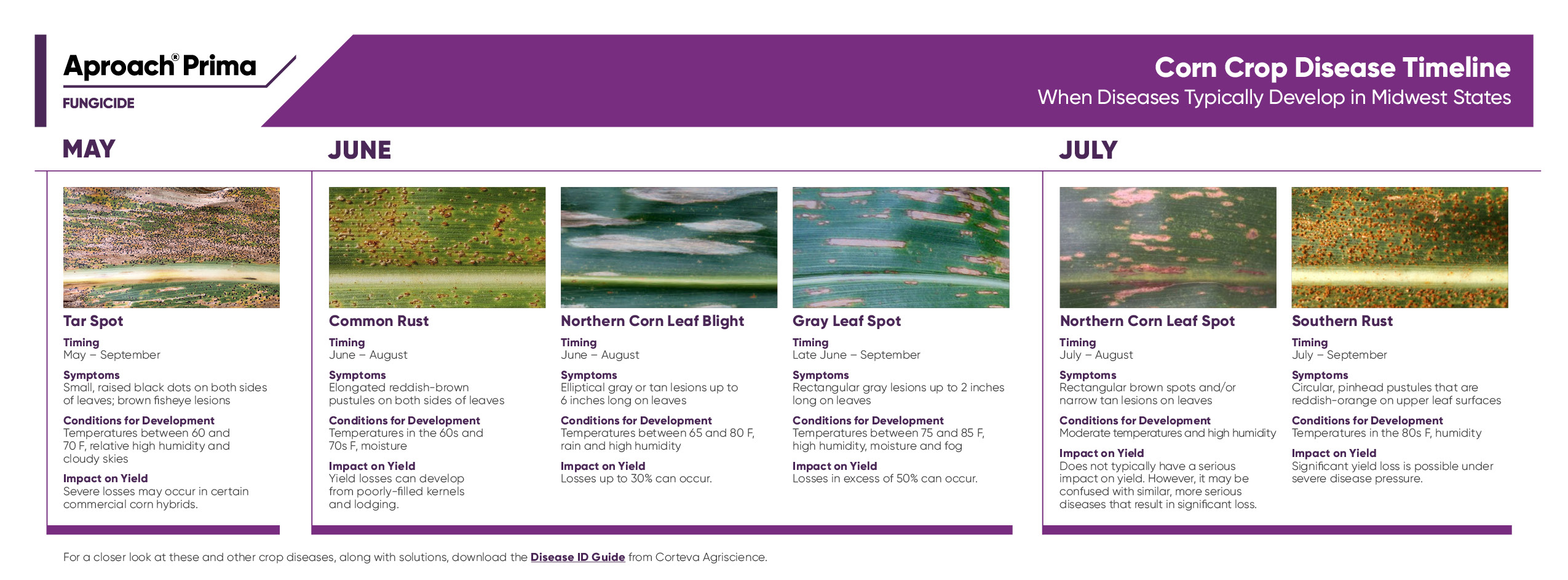Corn Diseases 101 – Preserving Yield Potential with a Proven Fungicide

Farmers across the Midwest Corn Belt, particularly in the northern areas, may be facing lingering impacts of a La Nina weather pattern that began in late fall 2024 and was expected to continue into early spring of this year. That weather pattern favored below normal temperatures, rain and possibly snow.
Although it does come with slight risks, progressive Midwest farmers know that getting the crop in the ground earlier than later may lead to higher yield potential, an earlier harvest and more time to prepare fields for the next growing season. They also know there is a risk of corn fungal diseases developing, potentially impacting their crop’s plant health and possibly reducing yield potential.
“There are several corn diseases farmers need to be cognizant of, but identifying and establishing the level of any disease starts with frequent and thorough scouting,” says Joe Bolte, market development specialist, Corteva Agriscience. “In a normal year, scouting should begin in June and into July. Monitoring weather patterns conducive to disease development and basing fungicide applications on the progression of the crop’s growth stage is much more important than basing those applications off planting dates.”
Although fungicides can provide both preventative and curative activity, protecting plants with proven and trusted fungicides prior to disease development, or at best, very early in its development, is always advised.
Corn acres are sometimes rotated to soybeans across the Midwest. Corn-on-corn acres and rotated acres can promote diseases, so it’s important for farmers to scout their fields. Crop residue harbors most corn-disease-related pathogens except southern rust, whose spores are carried into Midwest corn regions at the whim of winds blowing in from the south. For that reason, southern rust typically develops later in the growing season. On the other hand, tar spot overwinters within crop residue – waiting for optimal conditions to infect a living host.
“Tasseling (VT) to silking (R1) is the period in corn plant development where susceptibility to diseases can occur. Many studies confirm this also is a great time to apply fungicide to control many common corn diseases in the Midwest,” Bolte says. “Tar spot can occur earlier in the season and can progress quickly from a few lesions on leaves to a severe infection across the entire crop. It also can have multiple generations, so scouting for signs of the disease should start around the V8 growth stage.”
Other diseases that overwinter in the Midwest include gray leaf spot, northern leaf blight, and northern corn leaf spot. Being aware of the environmental conditions contributing to their development, recognizing their symptoms and understanding the months you most likely will find them while scouting are easily referenced in the chart below.

The Crop Protection Network, a multi-state, international partnership of university and provincial Extension specialists providing unbiased research-based information, maintains a Maps page on their website dedicated to tracking the movement of key corn and soybean-related diseases. Additional information on southern rust and tar spot, the states and counties where they have been found, and a table summarizing the possible benefits of applying fungicides also is available on the page.
A fungicide should provide fast uptake by quickly surrounding plant leaves and the plant stem. It should improve crop quality and yield potential by providing both preventative and curative activity.
“If a corn farmer needs a two-mode of action fungicide that delivers each of those qualities and more, I always recommend Aproach Prima fungicide,” Bolte says. “It’s a great fit for corn acres across the Midwest and will control many of our main fungal diseases in corn and soybeans. The fungicide helps farmers overcome gray leaf spot, northern corn leaf blight, common rust, southern rust and, of course, tar spot. Farmers can look to the Crop Protection Network’s chart for fungicide efficacy in corn to support Aproach Prima's efficacy on these key diseases.”
Aproach® Prima fungicide protects crop health with four distinct movement properties that surround and penetrate the leaves and stems. The fungicide is fast working with uptake starting on day one – nearly twice as fast as competitors. Additionally, Aproach Prima fungicide has two modes of actions to allow for a greater application window and strong defense against fungicide-resistant diseases.
The fungicide is registered by the U.S. Environmental Protection Agency for use in multiple crops, which makes it a simple and logical choice for growers with many crops to protect. It is recommended to not mix Aproach Prima fungicide with an adjuvant or crop oil when spraying corn between the V8 and VT growth stages.
Want to know more about Aproach Prima fungicide? Visit Corteva.US.
Aproach® Prima is not registered for sale or use in all states. Contact your state pesticide regulatory agency to determine if a product is registered for sale or use in your state. Always read and follow label directions.
Find expert insights on agronomics, crop protection, farm operations and more.